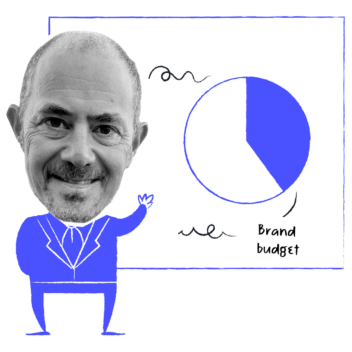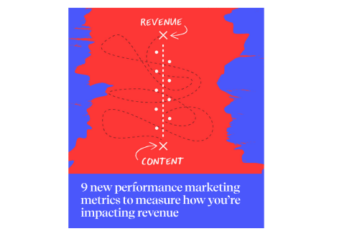
1. What used to be the coloring-in department is now a joyless pipeline sweatshop.





(and MQLs are Bullshit)
A New Sort-of B2B Manifesto

8 mins left
If a CMO went to sleep in 1994 and woke up today, she’d think she was on another planet.
And she’d be right.


1. What used to be the coloring-in department is now a joyless pipeline sweatshop.

2. The motivational posters are now real-time dashboards (with, like, charts and numbers).

3. The Senior VP of Ideation had been replaced by three MarTech geeks and an LLM.
The good news…
It’s the Golden Age of Accountability. Marketing has finally earned a place at the mythical Top Table.
The bad news…
That CMO who just woke up also just got fired. Today, senior marketing tenures are measured in hours.

The MQL machine is grinding to a halt.
The modern B2B marketing stack is an AI-guided, data-spewing, marvel of automation.
And the Ops people who built and run it are the smartest, coolest, humblest and most patient people you will ever meet.


The fact that B2B marketing has hit a wall is not their fault.

Because, while trying to master this weird new game, we all took our eyes off the most important ball in the pit.
We forgot we’re trying to move people.
Not ‘personas’ or ‘MQLs’ or even ‘accounts’.
People.
And people are not decision-making bots—they have elbows and cholesterol and minds of their own and feelings.
Revenge of the snowflakes.
As we all burned sacrifices to the Data God, hard-nosed Revenue People took over and ‘creative’ types were laughed out of the room.
But then things got weird.
Because, as we learned to analyze our spending and attribute the outcomes… what the data showed—clearly and unequivocally—is not what the EVP of Sales expected….


Anyone who has gone deep into performance marketing or ABM or demand gen has discovered a very strong signal, hiding in the noise:
A clear, compelling brand runs circles around a weak, unfocused brand every day of every week.
And the struggle for budget between demand gen tactics and brand-building is bullshit.
You need both.
(Binet & Field knew it all along and proved it in a series of excellent studies).


B2B is waking up.
A powerful brand is a major, measurable advantage in every B2B market.
And when you combine that brand with tight, efficient, transparent Performance Marketing, you will take home all the goodies. Fame, fortune, market share, momentum… pick your metrics.

Show me a company with runaway demand gen costs and I’ll show you a company with limited brand awareness.Joe Chernov
CMO at Pendo
But not the old-style brand that roamed the earth when our CMO nodded off.
The new B2B brand is not just about a recognized name.
It’s a clear positioning (that gives your best customers something to get excited about).
With a clearly articulated Galvanizing Story (that unifies everything you do).
And a top-to-bottom performance blueprint (that takes your story to market in ways that pay you back).
Today, a great brand is woven into the entire go-to-market fabric.
It’s not laid on top, it’s integrated (we’ll see how in a sec).


The best B2B brands outperform their rivals on every competitive front.
They may not be the biggest in their market (yet) but they’re the ones who punch way above their weight.
I’m just gonna pick one out of a very small hat: HubSpot.
We know who HubSpot is.
We know why they do what they do.
We know who they’re for.
We know they’re all about giving above-and-beyond value to their customers (and prospects).
And because we know all that, we’re open to their content and emails and ideas.
Instead of the usual marketing headwind (triggered by the merciless onslaught of the old B2B playbook), they get the benefits of a marketing tailwind.
Everything is easier.


Because measuring brand impact is harder than measuring MQLs.
And, somehow, ‘hard’ became synonymous with ‘impossible’.
And because marketing departments are addicted to Sugar Rush ‘leads’.
Despite knowing that those leads don’t actually lead anywhere.
And because we still think our only job is to convince people with logical business cases.
Instead of also moving people by tickling their soft underbellies.
The new B2B imperative is to weld a strong brand to an efficient performance marketing machine.
We know this is what works today. It’s time to make it happen.
Okay, stop scolding. Start giving Practical Tips™
The eight essentials of the new, brand-driven B2B.
Jon Miller recently advised B2B companies to invest 40% of their budgets in brand.
Jon. Miller.
Forty. Percent.
By our finger-in-the-air reckoning, that’s a 4-to-18-fold increase over current levels.

To make that kind of leap, you need all your stakeholders on board.
(If that sounds daunting, you might draw strength from A Stakeholder Through The Heart).

Brand-only content is content whose only job is to communicate your brand positioning and signal your brand qualities. Nothing else.
So your brand-only content could do things like this:
If people don’t agree it’s a problem, you have a problem.
Make content that shows people how all that weird pain is tied to this one big issue.
Once they get that, they’ll want some pain relief.
If you’re a procurement company and you hate waste, make content all about—and only about— that hate.
Don’t connect it directly to your products.
There’ll be plenty of times and places for that.
Just riff on waste.
You’re not for everyone. You’re for specific kinds of people.
So make those people heroes—in public.
Love them up.
(No, not in ‘case stories’… in profiles and videos and love letters and interviews and blog posts and patchwork quilts…)
This is brand-only content and it’s powerful stuff.
Only confident brands do it.
Be a confident brand.
Some folks* see anything brand adjacent as squishy and unserious.
But that is (ironically enough) a branding problem.
(*We’re not saying CFOs. But we’re not not saying that either.)
More specifically, it’s a framing issue. Investing 40% of your budget in brand isn’t about taking resources away from other initiatives.
It’s about ensuring the stuff you’re already doing actively strengthens the things you want to be known for. And that’s a lot easier for the folks white-knuckling the purse strings to buy into.
Brand is not about shouting louder, or more often. It’s about making your buyer’s life easier.

Everything you do that isn’t asking someone to buy right now (which should be a lot given 95% of your target audience isn’t actually in-market at any given time) is a chance to earn equity — so that when they are ready to buy, your name is in the hat. Or at least near it.
That webinar series? Done well, that’s a brand play.
Your data sheets? That’s a brand play.
Your customer success program? Friend, you better believe that’s a brand play.

No brand is an island.
Yours needs to be tightly integrated with your Performance Marketing strategy.
That means creating a single Playbook that captures everything in one place:

When you bring all this together in one Playbook, it’s a lot easier to make sure it’s all pulling in the same direction.
We’re releasing a workbook about how to do just that. Drop your email below to get a copy when it’s ready.
We hate hearing people say ‘Content marketing doesn’t work any more’.
That’s not true.
Siloed, tactical, ad hoc, robo-created content doesn’t work.
But smart, strategic, systematic, crafted content does work—in fact, you can’t do B2B without it.
Put away the paint-by-numbers content plan.
Think about your Galvanizing Story, your brand and your performance program.
Start fresh.
Get excited.
Hard, yes. Impossible, no.
Jon Miller (again) suggests A/B tests that compare buying groups who were exposed to brand advertising with those who weren’t.
(We call that “Engaged User Conversion” — it’s one of 9 custom metrics we use to measure how content and brand impact revenue. Check out the other 8 here.)
But you can also use brand trackers, engagement data and other indicators of brand uplift that precede (but can logically be tied to) revenue.
The more ways you measure the impact of your brand investments, the easier it will get– and the more impact you’ll see.

If you’re doing it right, B2B marketing should be lots of fun.
Full of creativity and experiments and optimism.
When you bring brand back into the picture, everything gets more fun.
Instead of saying, “We need to do this thing like those guys did”, you say, “How could we do this thing? How do we make it ours? How do we infuse it with brand pheromones?”
Fun is a KPI.
A leading indicator that you’re starting to be YOU.

We don’t spend enough time talking about the sheer delight of creating things we love—things that we co-create with our brains, our hearts, our hands, our whole selves…Ann Handley
CCO at MarketingProfs, speaker, author of "Everybody Writes"
Okay, marketing is science.
But it’s also an art.
Pick a few high-profile things and give them the time, budget and love they deserve.
Hire a great writer and designer.
Get the best devs you can find.
Tell Chat-GPT to fuck right off.
Make something beautiful.
People will respond to that.


Things get better when we make better things.Jay Acunzo
Consultant, speaker, author of "Break the Wheel"
Sum it up, Velocity

The old B2B playbook has fizzled out.
The new one starts with a clear, compelling, focused, delightful brand.
Then infuses every performance marketing initiative with that brand.
As standalone assets, your brand and your performance machine are powerful things.
Brought together, they’re unstoppable.
We love talking about these things—with each other, with our clients and with potential clients (like you?).
Get in touch and we’ll send you some cool content about brands and performance marketing and content and playbooks.




Hey look: a teeny-tiny cookie request. Would you mind? It’d help us out. Click here to read our privacy policy to see why. Or hit “customize” if you’re fancy like that.
Some of these cookies are essential, while others help us to improve your experience by providing insights into how the site is being used.
For more detailed information on the cookies we use, please check our privacy policy.
Necessary cookies enable core functionality. The website cannot function properly without these cookies, and can only be disabled by changing your browser preferences.
Analytical cookies help us to improve our website by collecting and reporting information on its usage.
Avertising cookies help us to understand if you visited our site after seeing or clicking an online advert.
Personanlization cookies help us to provide you with a personalized browsing experience.
Comments
There are no comments yet for this post. Why not be the first?